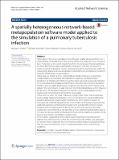A spatially heterogeneous network-based metapopulation software model applied to the simulation of a pulmonary tuberculosis infection
Abstract
Tuberculosis (TB) is an ancient disease that, although curable, still accounts for over 1 million deaths worldwide. Shortening treatment time is an important area of research but is hampered by the lack of models that mimic the full range of human pathology. TB shows distinct localisations during different stages of infection, the reasons for which are poorly understood. Greater understanding of how heterogeneity within the human lung influences disease progression may hold the key to improving treatment efficiency and reducing treatment times. In this work, we present a novel in silico software model which uses a networked metapopulation incorporating both spatial heterogeneity and dissemination possibilities to simulate a TB infection over the whole lung and associated lymphatics. The entire population of bacteria and immune cells is split into a network of patches: members interact within patches and are able to move between them. Patches and edges of the lung network include their own environmental attributes which influence the dynamics of interactions between the members of the subpopulations of the patches and the translocation of members along edges. In this work, we detail the initial findings of a whole-organ model that incorporates distinct spatial heterogeneity features which are not present in standard differential equation approaches to tuberculosis modelling. We show that the inclusion of heterogeneity within the lung landscape when modelling TB disease progression has significant outcomes on the bacterial load present: a greater differential of oxygen, perfusion and ventilation between the apices and the basal regions of the lungs creates micro-environments at the apex that are more preferential for bacteria, due to increased oxygen availability and reduced immune activity, leading to a greater overall bacterial load present once latency is established. These findings suggest that further whole-organ modelling incorporating more sophisticated heterogeneities within the environment and complex lung topologies will provide more insight into the environments in which TB bacteria persist and thus help develop new treatments which are factored towards these environmental conditions.
Citation
Pitcher , M J , Bowness , R , Dobson , S A & Gillespie , S H 2018 , ' A spatially heterogeneous network-based metapopulation software model applied to the simulation of a pulmonary tuberculosis infection ' , Applied Network Science , vol. 3 , 33 . https://doi.org/10.1007/s41109-018-0091-2
Publication
Applied Network Science
Status
Peer reviewed
ISSN
2364-8228Type
Journal article
Description
This work was supported by the PreDiCT-TB consortium (IMI Joint undertaking grant agreement number 115337, resources of which are composed of financial contribution from the European Union’s Seventh Framework Programme (FP7/2007-2013) and EFPIA companies’ in kind contribution.Collections
Items in the St Andrews Research Repository are protected by copyright, with all rights reserved, unless otherwise indicated.

